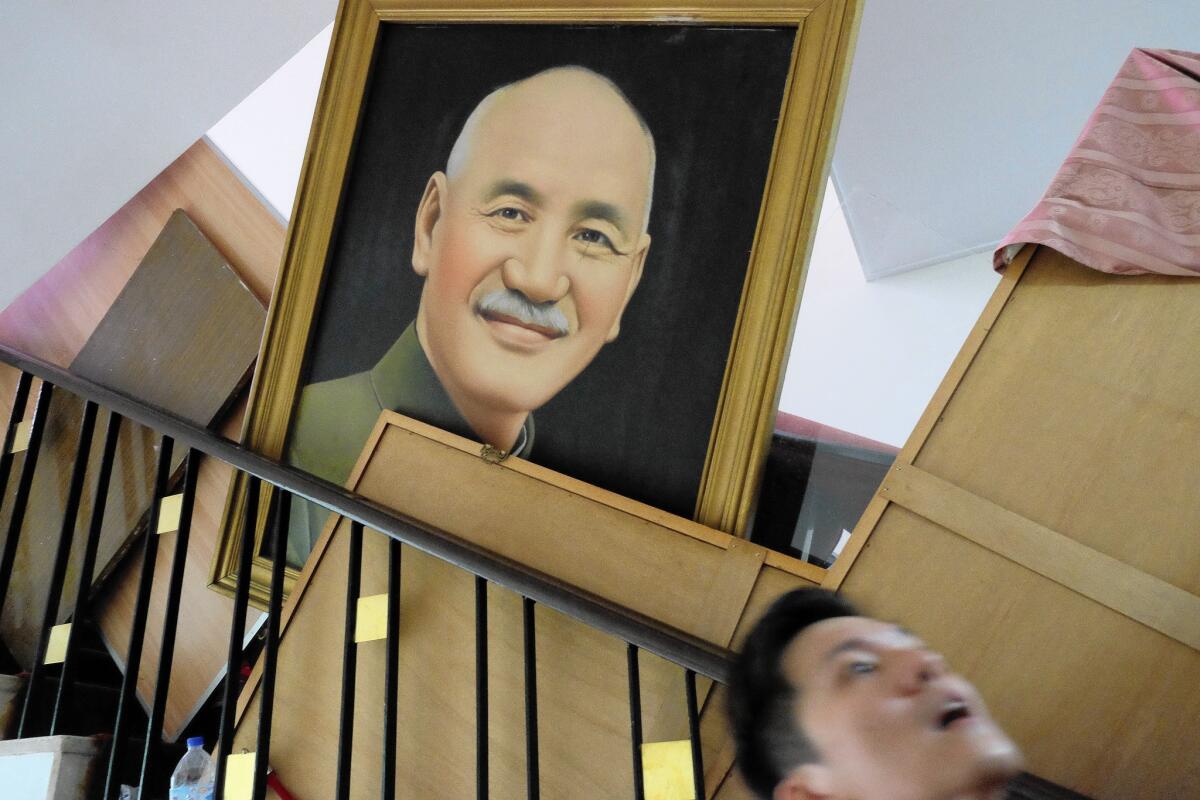In Taiwan, teens protest statues honoring former ruler Chiang Kai-shek

- Share via
reporting from TAIPEI, Taiwan — Nearly 40 years after Chiang Kai-shek’s death, statues of the autocratic leader continue to loom large on school campuses across the island he long ruled. The smiling, balding bronze and stone figures are ubiquitous to the degree that many students barely notice them.
In recent weeks, however, indifference turned to hostility when students from seven Taiwanese high schools united to mark the 1987 anniversary of the end of martial law first imposed by Chiang. The young protesters demanded that effigies of the three-decade ruler be removed.
“Just because students are used to seeing his statues doesn’t mean they think the statues are right,” said Tung Lee-wei, 16, a first-year student at Cheng Kung Senior High School in Taipei who helped organize the campaign.
The placard-festooned protests were the latest broadside against both the memory of Chiang and the current rule of his old Kuomintang, or Nationalist, party. Critics concerned that repressive rule could return to the democratically run island are particularly alarmed as its government grows closer economically to longtime archrival China.
Attention to the 6 1/2-foot-tall statues, as well as to roads and landmarks bearing Chiang’s name, has grown since hundreds of protesters led by university students occupied parliament in March and April.
Labeled the Sunflower Movement, the critics started out opposing fast-track legislative approval of a trade pact with China. Their ranks welled as the list of grievances grew.
“The Sunflower Movement is an awakening movement among the young in Taiwan,” said Joseph Wu, secretary general of Taiwan’s chief opposition group, the Democratic Progressive Party. “The newest move by the high school students represents an awakening to question the existence of Chiang’s statues when Taiwan is supposed to be democratized.”
The first effort to excise memories of Chiang came during the only period of non-Nationalist rule, from 2000 to 2008. Then-opposition President Chen Shui-bian stripped Chiang’s name from a Taipei plaza anchored by a monument and removed the appellation “Longevity for Chiang Kai-shek” from a central Taipei boulevard.
Chen, backed in part by Taiwanese who lived on the island before Chiang and his backers fled here as Mao Tse-tung’s Communists took control of China in the 1940s, also ordered statues removed from military property.
Taiwan has been separately ruled since Chiang’s Nationalists set up a rival government on the island and vowed to retake the mainland. Some Taiwanese, especially those who fled China with Chiang, credit him with resisting communism and fostering the rapid industrial growth that still anchors Taiwan’s economy.
“Chiang Kai-shek’s merits and demerits actually have pros and cons, but today’s youth possibly give too much attention to the cons,” Nationalist spokesman Charles Chen said. “Society now seldom discusses [the pros], especially among younger people, and that’s a regrettable point.”
But critics have long drawn attention to the execution and imprisonment of thousands of Chiang’s political opponents during his rule. Chiang died in 1975 and martial law was eventually lifted in 1987, allowing democracy to form. Here, citizens use the unregulated news media to criticize government officials, and they fear that under a single strongman or solo political party that right to free speech would be taken away.
The Ministry of Education takes no stand. If teachers, parents and administrators vote to remove a statue, the ministry will back them up, said Wang Cherng-shian, deputy director general of the ministry’s K-12 Education Administration. “When they can use a democratic process to decide, we’ll respect that,” Wang said.
He could not say how many schools still had Chiang statues.
At National Chengchi University, students have sought to remove three memorials to Chiang, who founded the Taipei institution known for its studies in diplomacy and international relations. But more people want the relics to stay, retired professor Leonard Chu said.
“The majority doesn’t see a continued need to remember or have a big ceremony over Chiang Kai-shek, because he’s very controversial,” said Lai I-chung, vice president of Taiwan Think Tank. “However, they don’t bother to take all the trouble with the process to remove him.”
At Taipei Municipal Chengyuan High School, a Chiang statue stands in the background. “Just leave it there,” said Yu Ching-chi, 14, as he hurried in uniform to a summer class at the central Taipei campus. “As long as we don’t have to mourn him like an ancestor, then it’s no problem.”
But sentiment is likely to eventually tilt against Chiang’s image, say student leader Tung and other protesters.
An advocacy group tapped to help the high school activists will try writing news commentary to further the cause, said Lin Yu-lun, 30, chief executive of the group, Taiwan Restoration of Social Justice. If that doesn’t work, he said, they will consider forcibly removing the statues.
“When he was in charge of Taiwan, he caused a lot of harm to people,” Lin said.
Jennings is a special correspondent.
More to Read
Sign up for Essential California
The most important California stories and recommendations in your inbox every morning.
You may occasionally receive promotional content from the Los Angeles Times.












